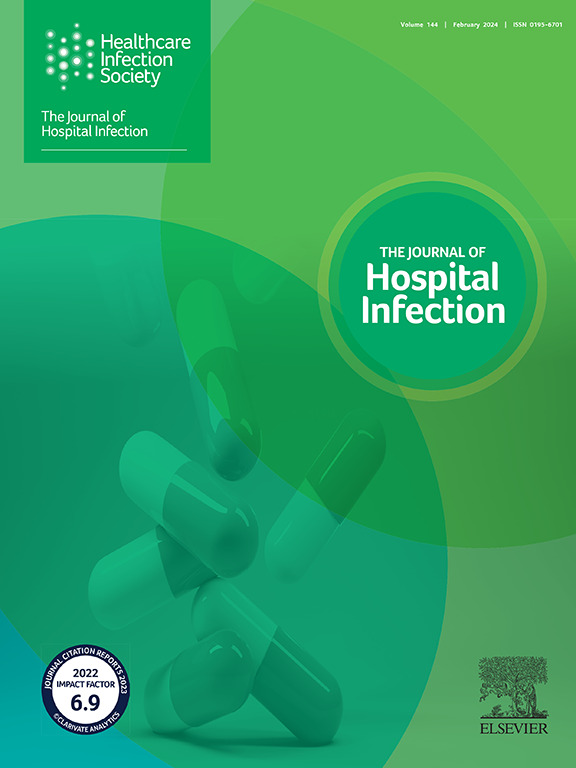More than rewards: insights into a hospital infection prevention and control gamification strategy
IF 3.9
3区 医学
Q1 INFECTIOUS DISEASES
引用次数: 0
Abstract
Background
Traditional infection prevention and control (IPC) education and training of healthcare workers (HCWs) is expensive and rarely sustainable. Gamification strategies support behavioural change by capitalizing on psychological drivers such as intrinsic and extrinsic motivation. However, little is known about which type of reward presentation best supports the engagement of HCWs.
Aim
To examine which reward strategy can best facilitate engagement and acquisition of IPC knowledge.
Methods
This study was performed in three gastroenterology wards, and a palliative care ward served as the control. Data on bed occupancy and consumption of alcohol-based hand sanitizer (ABHS) were collected over a 2-month baseline period, and the number of correct answers was gathered during the intervention phases. Surveys on expectation and satisfaction were conducted pre and post intervention. Twice-weekly knowledge quizzes used loss aversion, standard reward and in-game reward strategies. Multi-variate analysis was used to analyse data on ABHS consumption and IPC knowledge.
Findings
In total, 105 HCWs participated in this study. A 170% increase in mean ABHS consumption was observed between baseline and the last phase of gamification. This represents a significant effect of gamification (P<0.05). However, no significant difference in ABHS consumption was observed between the gamified wards (P>0.05). Furthermore, gamified strategies showed higher engagement than the control strategy, but strategies of loss aversion and standard rewards did not display higher ABHS consumption or game engagement compared with gamification alone.
Conclusion
The intervention effectively engaged medical and non-medical staff in IPC topics, positively influencing HCW work flow and increasing ABHS consumption. These findings highlight gamification as a promising approach for IPC education.
不仅仅是奖励:洞察医院感染预防和控制游戏化策略。
传统的感染预防和控制(IPC)教育和培训卫生保健工作者(HCW)是昂贵的,而且很少可持续,游戏化战略通过利用内在和外在动机等心理驱动因素来支持行为改变。然而,对于哪种类型的奖励表现最能支持HCW的参与,我们知之甚少。本研究旨在探讨哪种奖励策略可以促进IPC知识的参与和获取。该研究在三个胃肠病学病房进行,一个姑息治疗病房作为对照。在两个月的基线期间收集床位占用率、酒精类洗手液(ABHS)消耗的终点,在干预阶段收集正确答案的数量,并在干预前后进行期望和满意度调查。采用每周两次的知识测验、损失规避、标准奖励和游戏奖励策略进行干预。采用多变量分析方法分析ABHS消费与IPC知识的关系。105名HCW参与了研究,从基线到游戏化的最后阶段,平均ABHS消费量增加了170%。这代表了游戏化阶段的显著影响(p < 0.05)。然而,在游戏化病房之间没有观察到显著的消耗差异(p < 0.05)。此外,游戏化策略比对照组表现出更高的用户粘性,尽管厌恶损失和标准奖励策略并不比游戏化策略表现出更高的ABHS消耗或游戏粘性。干预有效地使医务人员和非医务人员参与IPC主题,积极影响HCW工作流程并增加ABHS消费。这些发现强调了游戏化是IPC教育的一种很有前途的方法。
本文章由计算机程序翻译,如有差异,请以英文原文为准。
求助全文
约1分钟内获得全文
求助全文
来源期刊

Journal of Hospital Infection
医学-传染病学
CiteScore
12.70
自引率
5.80%
发文量
271
审稿时长
19 days
期刊介绍:
The Journal of Hospital Infection is the editorially independent scientific publication of the Healthcare Infection Society. The aim of the Journal is to publish high quality research and information relating to infection prevention and control that is relevant to an international audience.
The Journal welcomes submissions that relate to all aspects of infection prevention and control in healthcare settings. This includes submissions that:
provide new insight into the epidemiology, surveillance, or prevention and control of healthcare-associated infections and antimicrobial resistance in healthcare settings;
provide new insight into cleaning, disinfection and decontamination;
provide new insight into the design of healthcare premises;
describe novel aspects of outbreaks of infection;
throw light on techniques for effective antimicrobial stewardship;
describe novel techniques (laboratory-based or point of care) for the detection of infection or antimicrobial resistance in the healthcare setting, particularly if these can be used to facilitate infection prevention and control;
improve understanding of the motivations of safe healthcare behaviour, or describe techniques for achieving behavioural and cultural change;
improve understanding of the use of IT systems in infection surveillance and prevention and control.
 求助内容:
求助内容: 应助结果提醒方式:
应助结果提醒方式:


